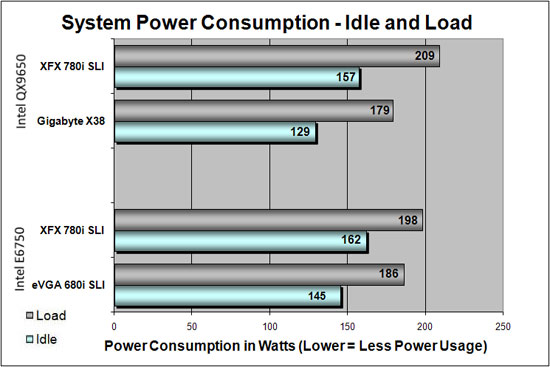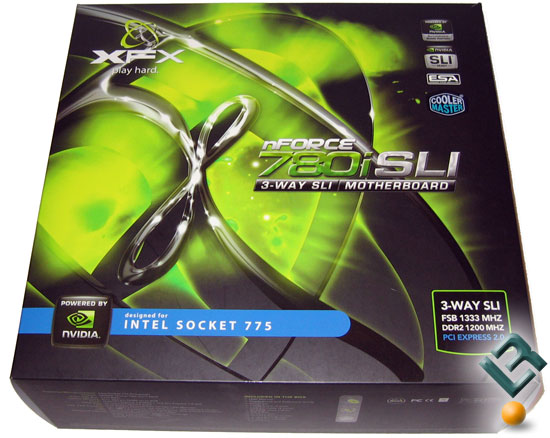XFX nForce 780i SLI Motherboard Review
Power Consumption and Conclusion
Power Consumption
For testing power consumption, we took our test system and plugged it into a Seasonic Power Angel. For idle numbers, we allowed the system to idle on the desktop for 15 minutes and took the reading. For load numbers, we measured the peak wattage used by the system while running the benchmark utility in POV-Ray 3.7 across all available cores.

Power Consumption Results: When it comes to power consumption the 780i is obviously going to be higher than the 680i because it has a bridge chip on the board. The difference between the 680i and 780i is 17W at idle, which is about what we expected to see. The extra nForce 200 bridge chip does make a difference as you can see. The 780i SLI consumed 28W more at idle and 30W more at load than the Gigabyte X38-DQ6 motherboard. The 780i SLI motherboard consumed 22% more power at load than the Gigabyte X38-DQ6 motherboard and 12% more than the eVGA 680i SLI motherboard. This higher power consumption is something to think about as the 780i SLI motherboard puts out more heat and uses more power than the previous generation 680i SLI motherboard.

Final Thoughts and Conclusions:
The NVIDIA nForce 780i SLI motherboard is an evolutionary advancement, not a revolutionary one. It adds features like support of 45nm Intel quad-core processors, which are not optional when you make a high end enthusiast board. NVIDIA is sure to sell many of these boards because they have an ace in their pocket that they love to have. That ace is 2-way and 3-way SLI and if you want to run SLI, then you have to run an NVIDIA chipset. When it comes to performance between the 680i and 780i our testing showed that a significant difference couldn’t be seen , but the 780i SLI also has new features that make it the motherboard to buy between the two.
When it comes to the actual chipset, it is amazing that NVIDA has been able to use the 680i/780i for so long. The NVIDIA nForce 780i SLI MCP is built on TSMC’s 90nm process technology, and contains the same exact micro-architecture as the NVIDIA nForce 680i SLI MCP. Eventually NVIDIA will have to design a new chipset to support even more features like 1600MHz FSB processors, DDR3 memory modules, and native PCI Express 2.0 graphics. Rumors of an upcoming NVIDIA 790i chipset in 2008 are going around, so chances are all these changes will take place then. For now the 780i SLI is the top dog when it comes to motherboards that support SLI and since no other company offers high-end SLI motherboards there really isn’t a choice to make!
The thing that impressed us most with the nForce 780i SLI motherboard had to be overclocking. It overclocked our Intel 45nm quad-core Yorkfield processors with ease. Our test system took the Intel Core 2 Quad QX9560 processor to over 4.1GHz and pushed the FSB from 1333MHz to 1900MHz. Reaching 475MHz FSB on a 45nm quad-core is great news for overclockers, but why doesn’t NVIDIA claim support for 1600MHz processors? That worries us, but maybe they have learned not to claim support for something until the product is shipping! �
Pricing on the XFX 780i SLI should be around $279 when they hit the streets in the next day or two.
The Legit Bottom Line: The aging NVIDIA 680i SLI motherboard finally loses it’s flagship status as the latest and greatest SLI board on the market. The NVIDIA 780i SLI motherboard is the new king of the hill for those that want the ultimate in Intel/NVIDIA platforms.

Comments are closed.